Environmental Epidemiology Assignment 1 - Foundations of Medicine 2
VerifiedAdded on 2022/08/26
|9
|2316
|24
Report
AI Summary
This report, prepared for Foundations of Medicine 2, explores the field of environmental epidemiology by investigating the casual relationship between environmental hazards and public health. The research begins with a defined research question and outlines a comprehensive search strategy, detailing data sources, keywords, and inclusion/exclusion criteria. A systematic review of relevant studies is conducted, summarizing the findings related to environmental health risks and their impact on populations. The methodologies employed in the studies and their outcomes are analyzed, followed by an evaluation of the biological plausibility of the reported associations. The report also identifies gaps in the existing literature and proposes directions for future research, emphasizing the complexities of integrating evidence from diverse sources and communicating risks effectively to the public and regulatory bodies. The study highlights various factors influencing health, including sanitation, diet, socioeconomic status, and lifestyle, and also discusses specific environmental health issues such as air pollution and contamination through the food chain. The report concludes by discussing the methodologies and results of risk analysis, the importance of biological plausibility, and the challenges in interpreting study outcomes and communicating risks to the public, emphasizing the need for transparent and open methods.
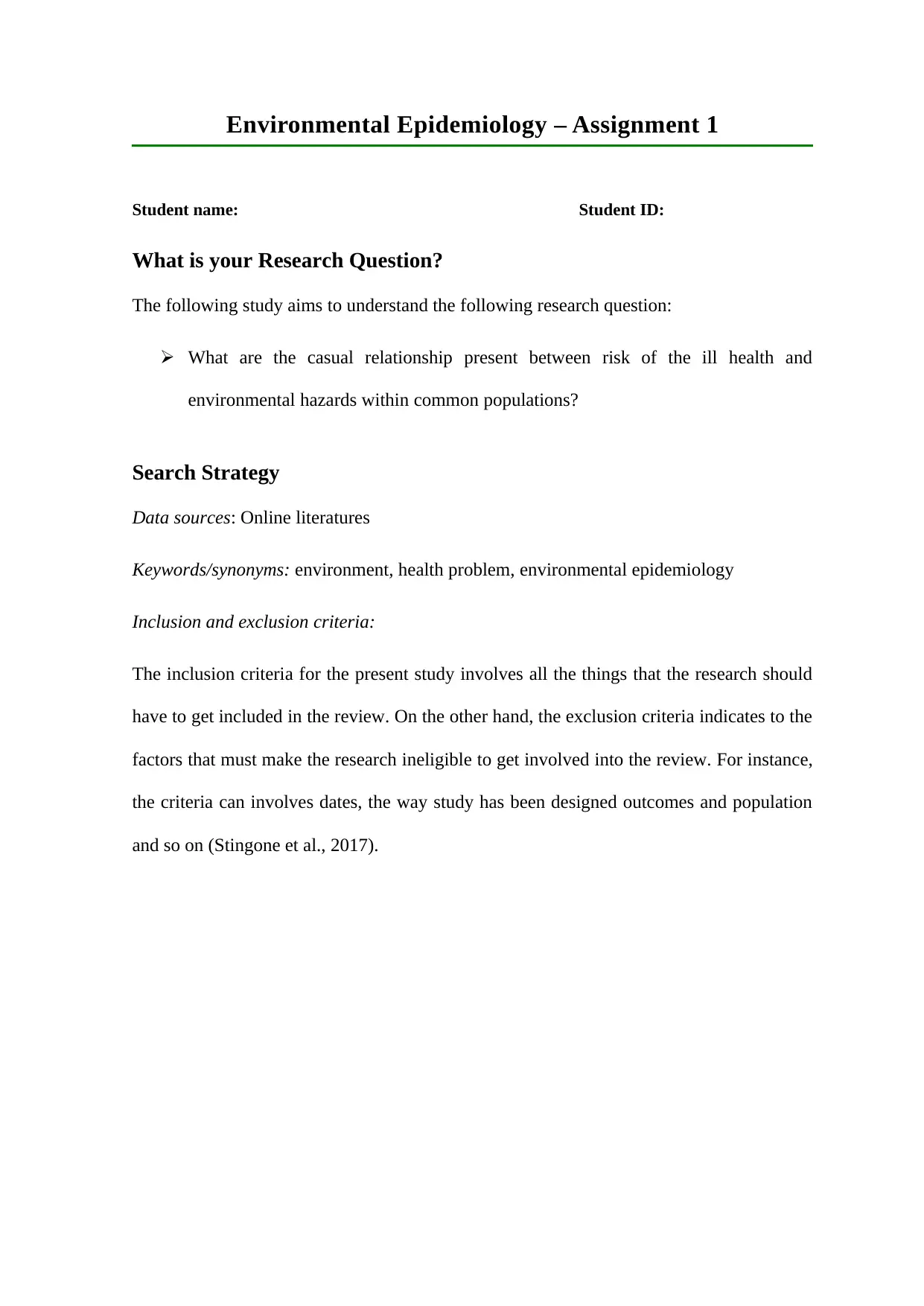
Environmental Epidemiology – Assignment 1
Student name: Student ID:
What is your Research Question?
The following study aims to understand the following research question:
What are the casual relationship present between risk of the ill health and
environmental hazards within common populations?
Search Strategy
Data sources: Online literatures
Keywords/synonyms: environment, health problem, environmental epidemiology
Inclusion and exclusion criteria:
The inclusion criteria for the present study involves all the things that the research should
have to get included in the review. On the other hand, the exclusion criteria indicates to the
factors that must make the research ineligible to get involved into the review. For instance,
the criteria can involves dates, the way study has been designed outcomes and population
and so on (Stingone et al., 2017).
Student name: Student ID:
What is your Research Question?
The following study aims to understand the following research question:
What are the casual relationship present between risk of the ill health and
environmental hazards within common populations?
Search Strategy
Data sources: Online literatures
Keywords/synonyms: environment, health problem, environmental epidemiology
Inclusion and exclusion criteria:
The inclusion criteria for the present study involves all the things that the research should
have to get included in the review. On the other hand, the exclusion criteria indicates to the
factors that must make the research ineligible to get involved into the review. For instance,
the criteria can involves dates, the way study has been designed outcomes and population
and so on (Stingone et al., 2017).
Paraphrase This Document
Need a fresh take? Get an instant paraphrase of this document with our AI Paraphraser
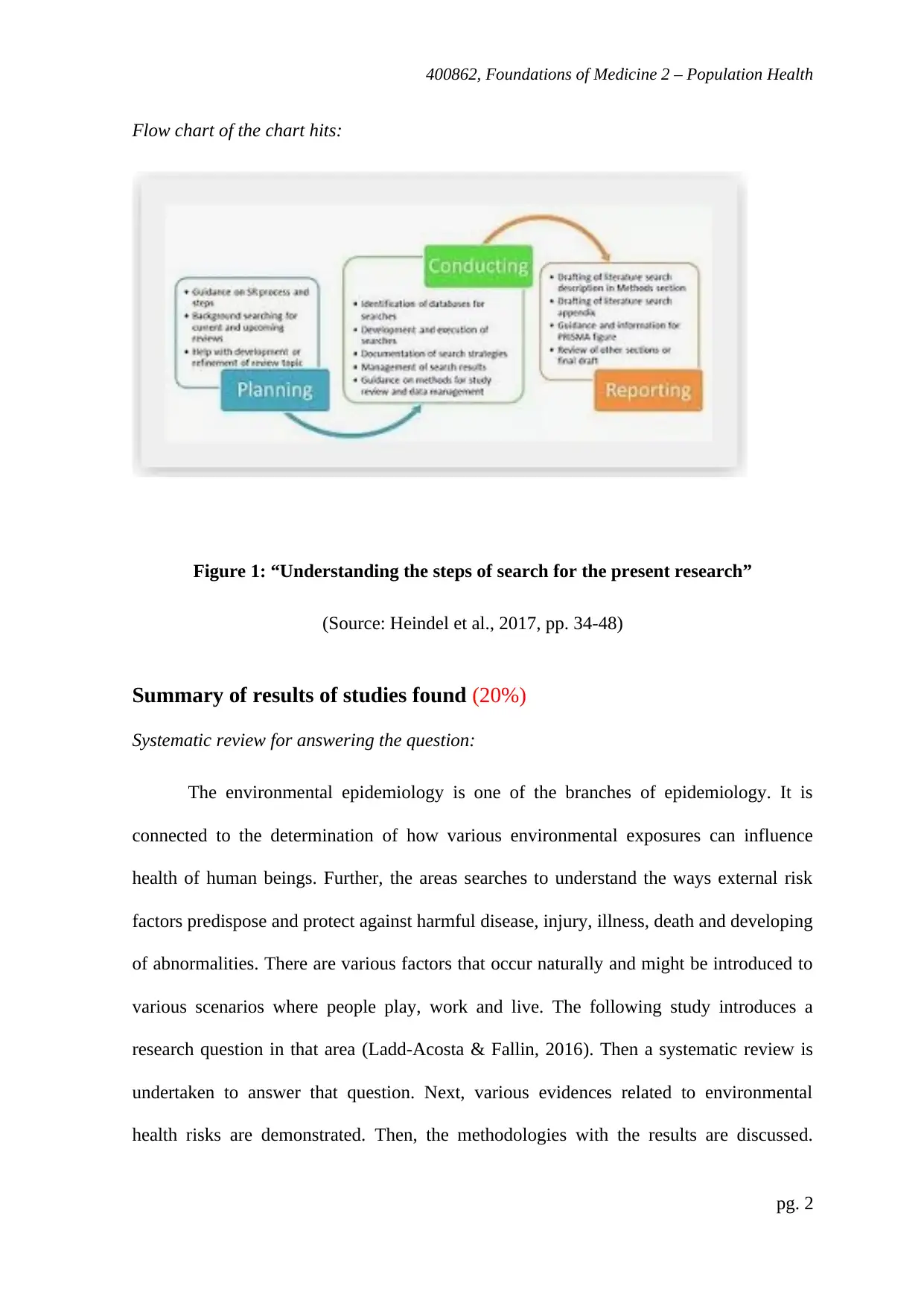
400862, Foundations of Medicine 2 – Population Health
Flow chart of the chart hits:
Figure 1: “Understanding the steps of search for the present research”
(Source: Heindel et al., 2017, pp. 34-48)
Summary of results of studies found (20%)
Systematic review for answering the question:
The environmental epidemiology is one of the branches of epidemiology. It is
connected to the determination of how various environmental exposures can influence
health of human beings. Further, the areas searches to understand the ways external risk
factors predispose and protect against harmful disease, injury, illness, death and developing
of abnormalities. There are various factors that occur naturally and might be introduced to
various scenarios where people play, work and live. The following study introduces a
research question in that area (Ladd-Acosta & Fallin, 2016). Then a systematic review is
undertaken to answer that question. Next, various evidences related to environmental
health risks are demonstrated. Then, the methodologies with the results are discussed.
pg. 2
Flow chart of the chart hits:
Figure 1: “Understanding the steps of search for the present research”
(Source: Heindel et al., 2017, pp. 34-48)
Summary of results of studies found (20%)
Systematic review for answering the question:
The environmental epidemiology is one of the branches of epidemiology. It is
connected to the determination of how various environmental exposures can influence
health of human beings. Further, the areas searches to understand the ways external risk
factors predispose and protect against harmful disease, injury, illness, death and developing
of abnormalities. There are various factors that occur naturally and might be introduced to
various scenarios where people play, work and live. The following study introduces a
research question in that area (Ladd-Acosta & Fallin, 2016). Then a systematic review is
undertaken to answer that question. Next, various evidences related to environmental
health risks are demonstrated. Then, the methodologies with the results are discussed.
pg. 2
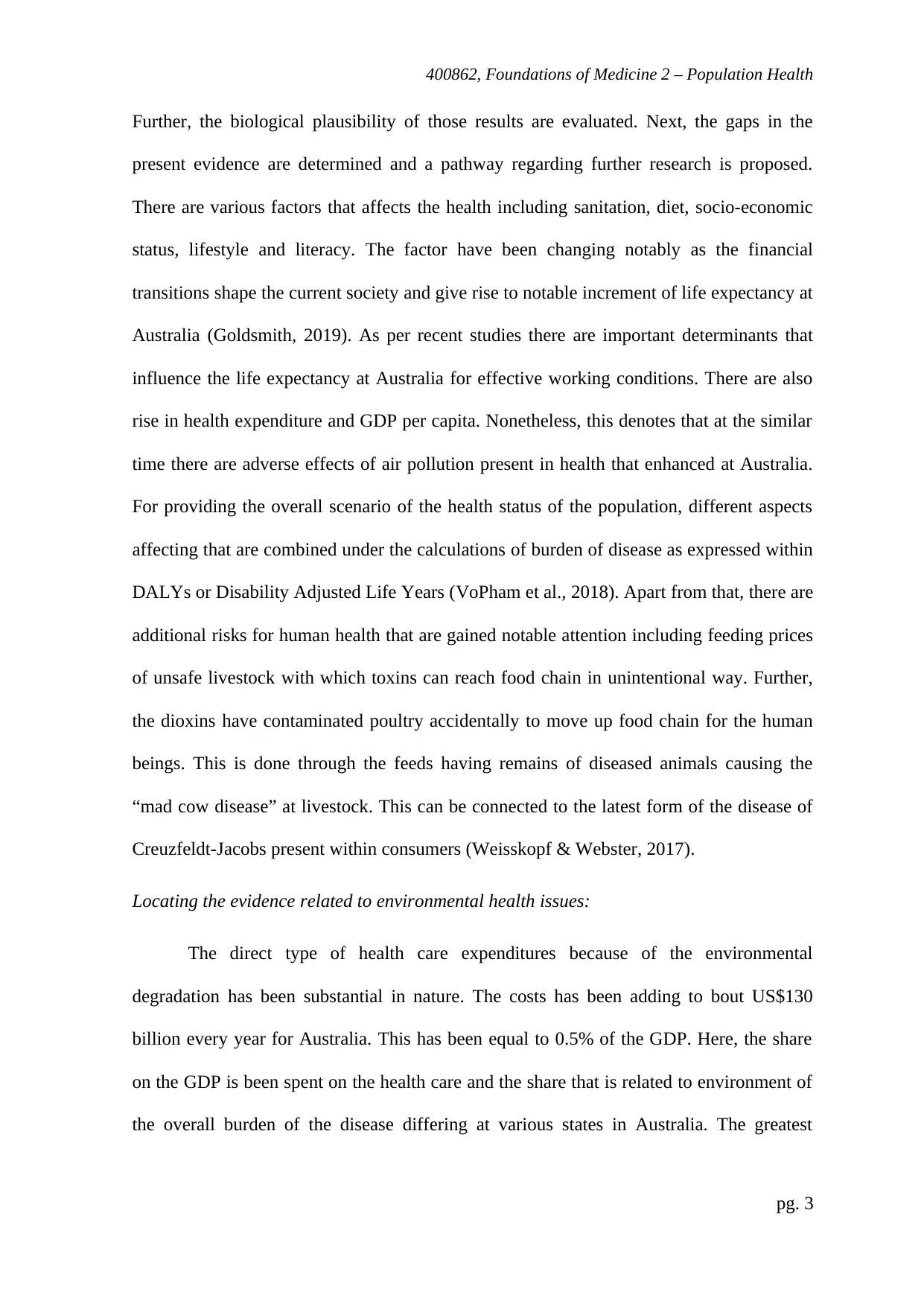
400862, Foundations of Medicine 2 – Population Health
Further, the biological plausibility of those results are evaluated. Next, the gaps in the
present evidence are determined and a pathway regarding further research is proposed.
There are various factors that affects the health including sanitation, diet, socio-economic
status, lifestyle and literacy. The factor have been changing notably as the financial
transitions shape the current society and give rise to notable increment of life expectancy at
Australia (Goldsmith, 2019). As per recent studies there are important determinants that
influence the life expectancy at Australia for effective working conditions. There are also
rise in health expenditure and GDP per capita. Nonetheless, this denotes that at the similar
time there are adverse effects of air pollution present in health that enhanced at Australia.
For providing the overall scenario of the health status of the population, different aspects
affecting that are combined under the calculations of burden of disease as expressed within
DALYs or Disability Adjusted Life Years (VoPham et al., 2018). Apart from that, there are
additional risks for human health that are gained notable attention including feeding prices
of unsafe livestock with which toxins can reach food chain in unintentional way. Further,
the dioxins have contaminated poultry accidentally to move up food chain for the human
beings. This is done through the feeds having remains of diseased animals causing the
“mad cow disease” at livestock. This can be connected to the latest form of the disease of
Creuzfeldt-Jacobs present within consumers (Weisskopf & Webster, 2017).
Locating the evidence related to environmental health issues:
The direct type of health care expenditures because of the environmental
degradation has been substantial in nature. The costs has been adding to bout US$130
billion every year for Australia. This has been equal to 0.5% of the GDP. Here, the share
on the GDP is been spent on the health care and the share that is related to environment of
the overall burden of the disease differing at various states in Australia. The greatest
pg. 3
Further, the biological plausibility of those results are evaluated. Next, the gaps in the
present evidence are determined and a pathway regarding further research is proposed.
There are various factors that affects the health including sanitation, diet, socio-economic
status, lifestyle and literacy. The factor have been changing notably as the financial
transitions shape the current society and give rise to notable increment of life expectancy at
Australia (Goldsmith, 2019). As per recent studies there are important determinants that
influence the life expectancy at Australia for effective working conditions. There are also
rise in health expenditure and GDP per capita. Nonetheless, this denotes that at the similar
time there are adverse effects of air pollution present in health that enhanced at Australia.
For providing the overall scenario of the health status of the population, different aspects
affecting that are combined under the calculations of burden of disease as expressed within
DALYs or Disability Adjusted Life Years (VoPham et al., 2018). Apart from that, there are
additional risks for human health that are gained notable attention including feeding prices
of unsafe livestock with which toxins can reach food chain in unintentional way. Further,
the dioxins have contaminated poultry accidentally to move up food chain for the human
beings. This is done through the feeds having remains of diseased animals causing the
“mad cow disease” at livestock. This can be connected to the latest form of the disease of
Creuzfeldt-Jacobs present within consumers (Weisskopf & Webster, 2017).
Locating the evidence related to environmental health issues:
The direct type of health care expenditures because of the environmental
degradation has been substantial in nature. The costs has been adding to bout US$130
billion every year for Australia. This has been equal to 0.5% of the GDP. Here, the share
on the GDP is been spent on the health care and the share that is related to environment of
the overall burden of the disease differing at various states in Australia. The greatest
pg. 3
⊘ This is a preview!⊘
Do you want full access?
Subscribe today to unlock all pages.

Trusted by 1+ million students worldwide
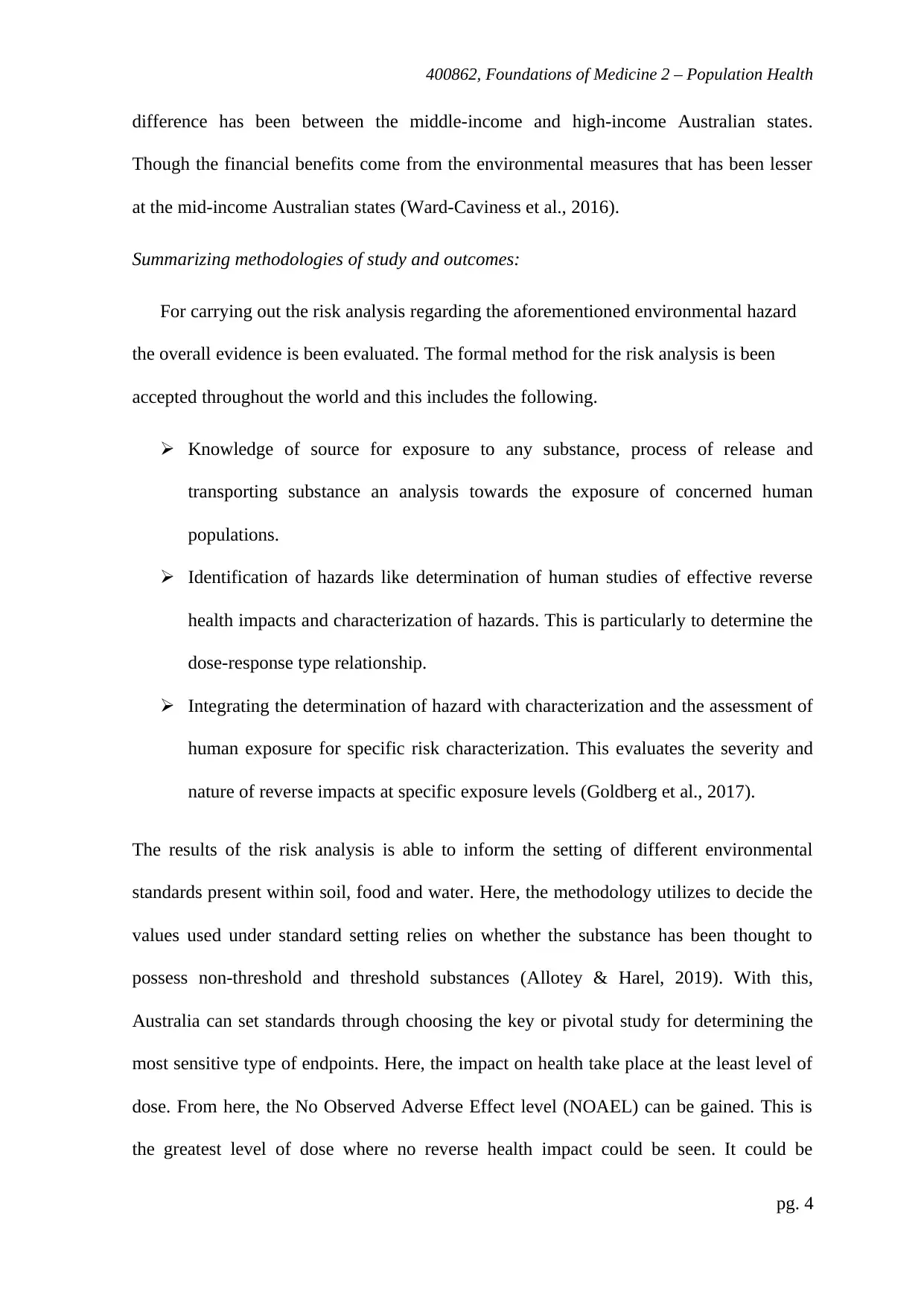
400862, Foundations of Medicine 2 – Population Health
difference has been between the middle-income and high-income Australian states.
Though the financial benefits come from the environmental measures that has been lesser
at the mid-income Australian states (Ward-Caviness et al., 2016).
Summarizing methodologies of study and outcomes:
For carrying out the risk analysis regarding the aforementioned environmental hazard
the overall evidence is been evaluated. The formal method for the risk analysis is been
accepted throughout the world and this includes the following.
Knowledge of source for exposure to any substance, process of release and
transporting substance an analysis towards the exposure of concerned human
populations.
Identification of hazards like determination of human studies of effective reverse
health impacts and characterization of hazards. This is particularly to determine the
dose-response type relationship.
Integrating the determination of hazard with characterization and the assessment of
human exposure for specific risk characterization. This evaluates the severity and
nature of reverse impacts at specific exposure levels (Goldberg et al., 2017).
The results of the risk analysis is able to inform the setting of different environmental
standards present within soil, food and water. Here, the methodology utilizes to decide the
values used under standard setting relies on whether the substance has been thought to
possess non-threshold and threshold substances (Allotey & Harel, 2019). With this,
Australia can set standards through choosing the key or pivotal study for determining the
most sensitive type of endpoints. Here, the impact on health take place at the least level of
dose. From here, the No Observed Adverse Effect level (NOAEL) can be gained. This is
the greatest level of dose where no reverse health impact could be seen. It could be
pg. 4
difference has been between the middle-income and high-income Australian states.
Though the financial benefits come from the environmental measures that has been lesser
at the mid-income Australian states (Ward-Caviness et al., 2016).
Summarizing methodologies of study and outcomes:
For carrying out the risk analysis regarding the aforementioned environmental hazard
the overall evidence is been evaluated. The formal method for the risk analysis is been
accepted throughout the world and this includes the following.
Knowledge of source for exposure to any substance, process of release and
transporting substance an analysis towards the exposure of concerned human
populations.
Identification of hazards like determination of human studies of effective reverse
health impacts and characterization of hazards. This is particularly to determine the
dose-response type relationship.
Integrating the determination of hazard with characterization and the assessment of
human exposure for specific risk characterization. This evaluates the severity and
nature of reverse impacts at specific exposure levels (Goldberg et al., 2017).
The results of the risk analysis is able to inform the setting of different environmental
standards present within soil, food and water. Here, the methodology utilizes to decide the
values used under standard setting relies on whether the substance has been thought to
possess non-threshold and threshold substances (Allotey & Harel, 2019). With this,
Australia can set standards through choosing the key or pivotal study for determining the
most sensitive type of endpoints. Here, the impact on health take place at the least level of
dose. From here, the No Observed Adverse Effect level (NOAEL) can be gained. This is
the greatest level of dose where no reverse health impact could be seen. It could be
pg. 4
Paraphrase This Document
Need a fresh take? Get an instant paraphrase of this document with our AI Paraphraser
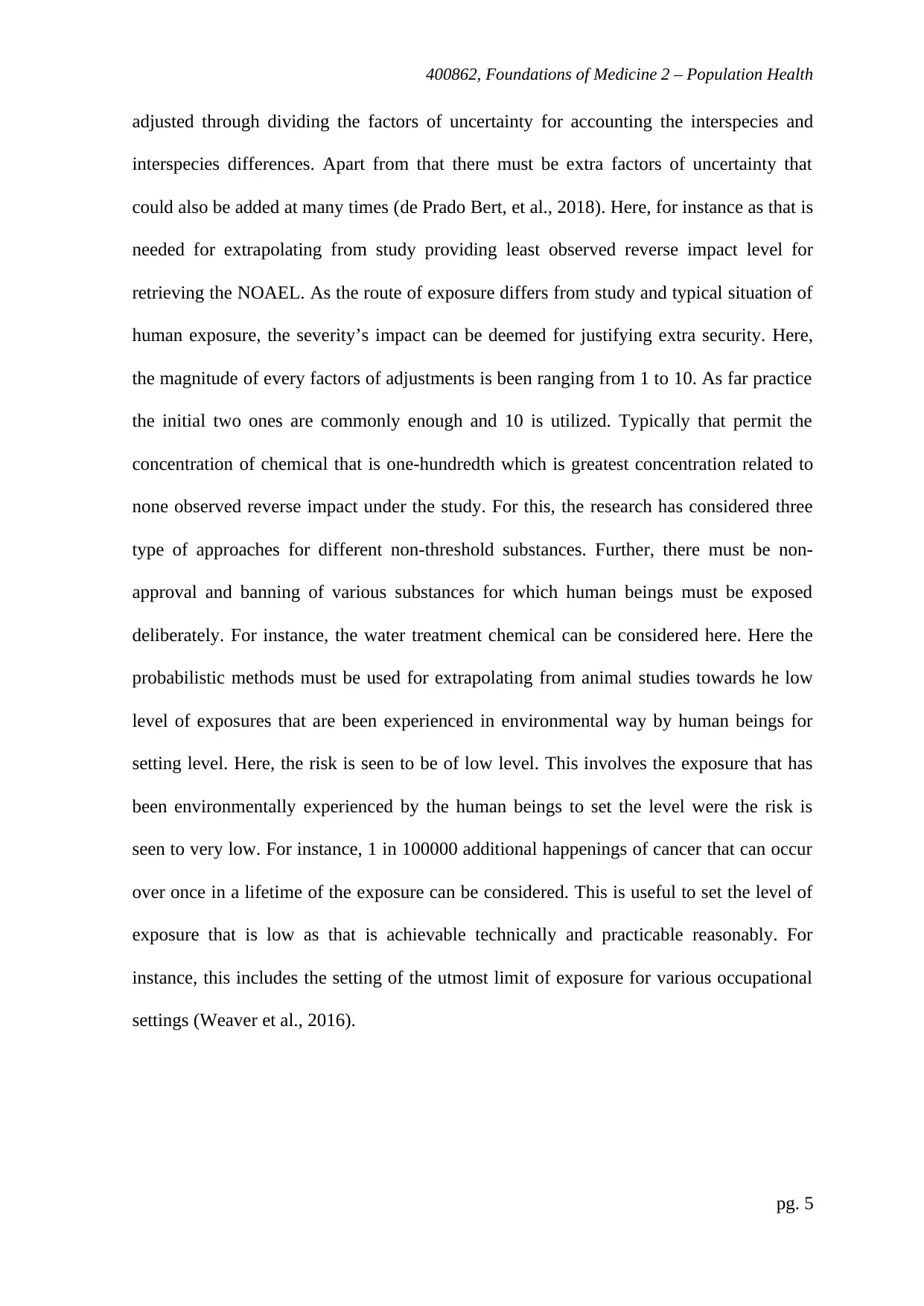
400862, Foundations of Medicine 2 – Population Health
adjusted through dividing the factors of uncertainty for accounting the interspecies and
interspecies differences. Apart from that there must be extra factors of uncertainty that
could also be added at many times (de Prado Bert, et al., 2018). Here, for instance as that is
needed for extrapolating from study providing least observed reverse impact level for
retrieving the NOAEL. As the route of exposure differs from study and typical situation of
human exposure, the severity’s impact can be deemed for justifying extra security. Here,
the magnitude of every factors of adjustments is been ranging from 1 to 10. As far practice
the initial two ones are commonly enough and 10 is utilized. Typically that permit the
concentration of chemical that is one-hundredth which is greatest concentration related to
none observed reverse impact under the study. For this, the research has considered three
type of approaches for different non-threshold substances. Further, there must be non-
approval and banning of various substances for which human beings must be exposed
deliberately. For instance, the water treatment chemical can be considered here. Here the
probabilistic methods must be used for extrapolating from animal studies towards he low
level of exposures that are been experienced in environmental way by human beings for
setting level. Here, the risk is seen to be of low level. This involves the exposure that has
been environmentally experienced by the human beings to set the level were the risk is
seen to very low. For instance, 1 in 100000 additional happenings of cancer that can occur
over once in a lifetime of the exposure can be considered. This is useful to set the level of
exposure that is low as that is achievable technically and practicable reasonably. For
instance, this includes the setting of the utmost limit of exposure for various occupational
settings (Weaver et al., 2016).
pg. 5
adjusted through dividing the factors of uncertainty for accounting the interspecies and
interspecies differences. Apart from that there must be extra factors of uncertainty that
could also be added at many times (de Prado Bert, et al., 2018). Here, for instance as that is
needed for extrapolating from study providing least observed reverse impact level for
retrieving the NOAEL. As the route of exposure differs from study and typical situation of
human exposure, the severity’s impact can be deemed for justifying extra security. Here,
the magnitude of every factors of adjustments is been ranging from 1 to 10. As far practice
the initial two ones are commonly enough and 10 is utilized. Typically that permit the
concentration of chemical that is one-hundredth which is greatest concentration related to
none observed reverse impact under the study. For this, the research has considered three
type of approaches for different non-threshold substances. Further, there must be non-
approval and banning of various substances for which human beings must be exposed
deliberately. For instance, the water treatment chemical can be considered here. Here the
probabilistic methods must be used for extrapolating from animal studies towards he low
level of exposures that are been experienced in environmental way by human beings for
setting level. Here, the risk is seen to be of low level. This involves the exposure that has
been environmentally experienced by the human beings to set the level were the risk is
seen to very low. For instance, 1 in 100000 additional happenings of cancer that can occur
over once in a lifetime of the exposure can be considered. This is useful to set the level of
exposure that is low as that is achievable technically and practicable reasonably. For
instance, this includes the setting of the utmost limit of exposure for various occupational
settings (Weaver et al., 2016).
pg. 5
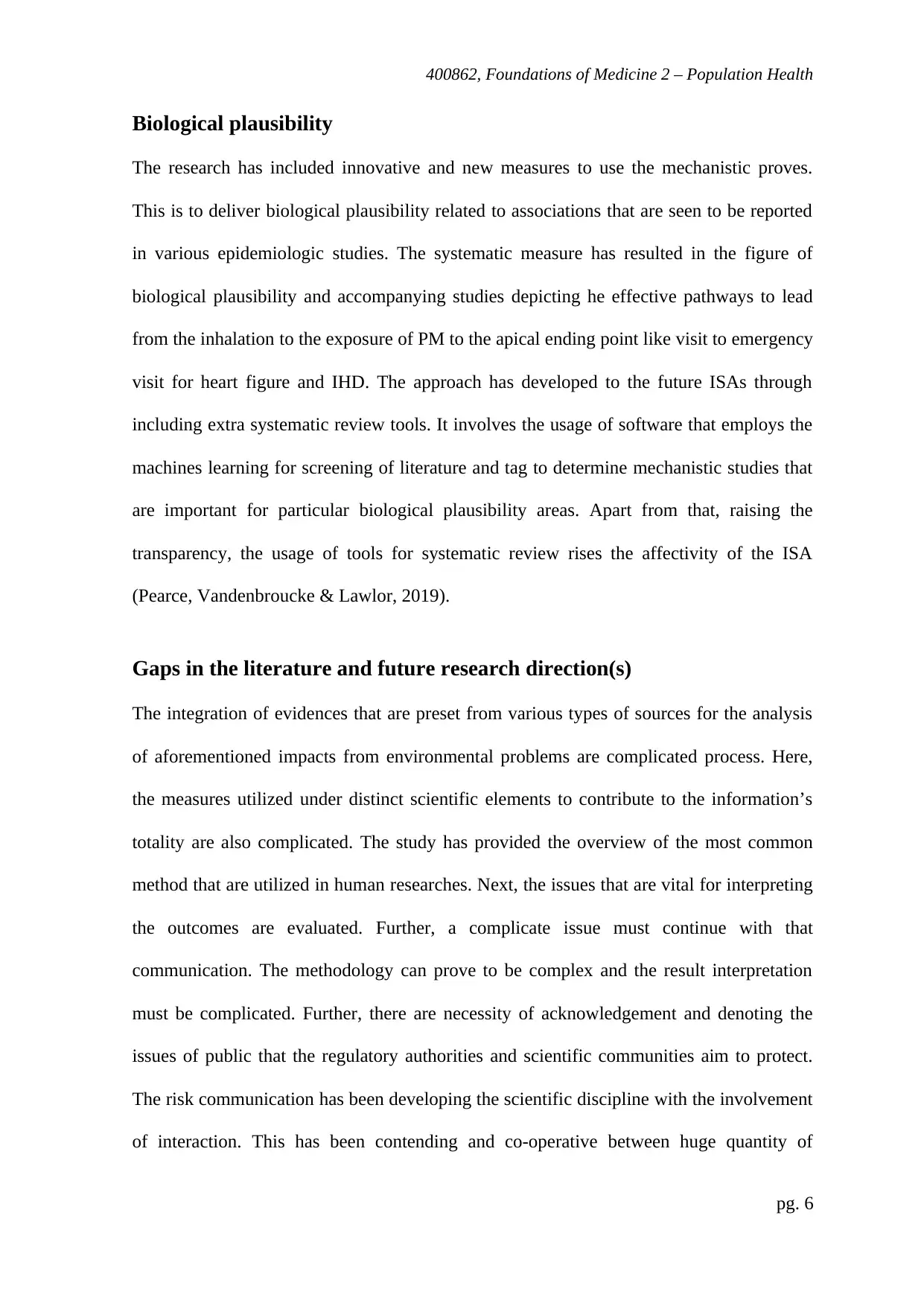
400862, Foundations of Medicine 2 – Population Health
Biological plausibility
The research has included innovative and new measures to use the mechanistic proves.
This is to deliver biological plausibility related to associations that are seen to be reported
in various epidemiologic studies. The systematic measure has resulted in the figure of
biological plausibility and accompanying studies depicting he effective pathways to lead
from the inhalation to the exposure of PM to the apical ending point like visit to emergency
visit for heart figure and IHD. The approach has developed to the future ISAs through
including extra systematic review tools. It involves the usage of software that employs the
machines learning for screening of literature and tag to determine mechanistic studies that
are important for particular biological plausibility areas. Apart from that, raising the
transparency, the usage of tools for systematic review rises the affectivity of the ISA
(Pearce, Vandenbroucke & Lawlor, 2019).
Gaps in the literature and future research direction(s)
The integration of evidences that are preset from various types of sources for the analysis
of aforementioned impacts from environmental problems are complicated process. Here,
the measures utilized under distinct scientific elements to contribute to the information’s
totality are also complicated. The study has provided the overview of the most common
method that are utilized in human researches. Next, the issues that are vital for interpreting
the outcomes are evaluated. Further, a complicate issue must continue with that
communication. The methodology can prove to be complex and the result interpretation
must be complicated. Further, there are necessity of acknowledgement and denoting the
issues of public that the regulatory authorities and scientific communities aim to protect.
The risk communication has been developing the scientific discipline with the involvement
of interaction. This has been contending and co-operative between huge quantity of
pg. 6
Biological plausibility
The research has included innovative and new measures to use the mechanistic proves.
This is to deliver biological plausibility related to associations that are seen to be reported
in various epidemiologic studies. The systematic measure has resulted in the figure of
biological plausibility and accompanying studies depicting he effective pathways to lead
from the inhalation to the exposure of PM to the apical ending point like visit to emergency
visit for heart figure and IHD. The approach has developed to the future ISAs through
including extra systematic review tools. It involves the usage of software that employs the
machines learning for screening of literature and tag to determine mechanistic studies that
are important for particular biological plausibility areas. Apart from that, raising the
transparency, the usage of tools for systematic review rises the affectivity of the ISA
(Pearce, Vandenbroucke & Lawlor, 2019).
Gaps in the literature and future research direction(s)
The integration of evidences that are preset from various types of sources for the analysis
of aforementioned impacts from environmental problems are complicated process. Here,
the measures utilized under distinct scientific elements to contribute to the information’s
totality are also complicated. The study has provided the overview of the most common
method that are utilized in human researches. Next, the issues that are vital for interpreting
the outcomes are evaluated. Further, a complicate issue must continue with that
communication. The methodology can prove to be complex and the result interpretation
must be complicated. Further, there are necessity of acknowledgement and denoting the
issues of public that the regulatory authorities and scientific communities aim to protect.
The risk communication has been developing the scientific discipline with the involvement
of interaction. This has been contending and co-operative between huge quantity of
pg. 6
⊘ This is a preview!⊘
Do you want full access?
Subscribe today to unlock all pages.

Trusted by 1+ million students worldwide
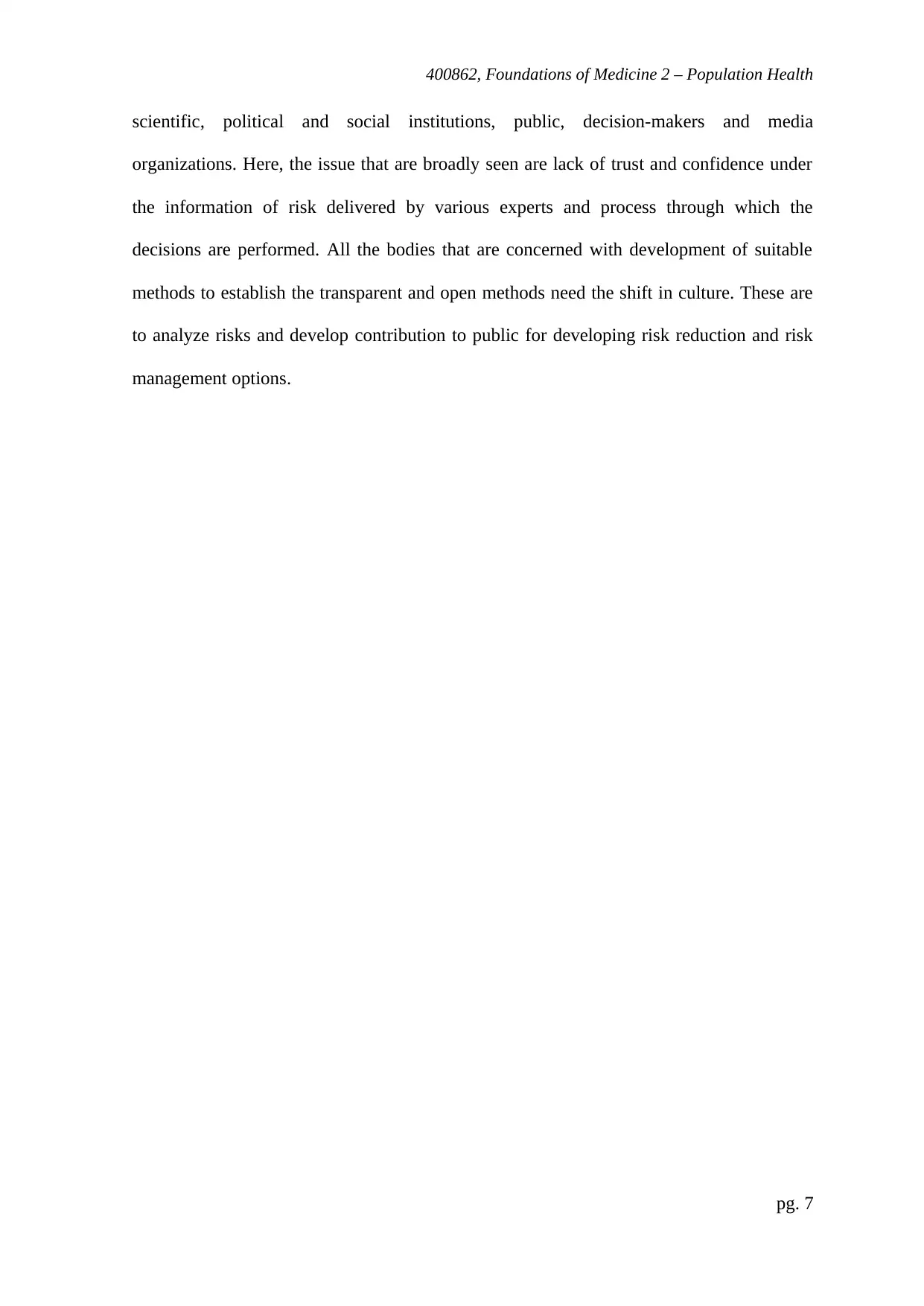
400862, Foundations of Medicine 2 – Population Health
scientific, political and social institutions, public, decision-makers and media
organizations. Here, the issue that are broadly seen are lack of trust and confidence under
the information of risk delivered by various experts and process through which the
decisions are performed. All the bodies that are concerned with development of suitable
methods to establish the transparent and open methods need the shift in culture. These are
to analyze risks and develop contribution to public for developing risk reduction and risk
management options.
pg. 7
scientific, political and social institutions, public, decision-makers and media
organizations. Here, the issue that are broadly seen are lack of trust and confidence under
the information of risk delivered by various experts and process through which the
decisions are performed. All the bodies that are concerned with development of suitable
methods to establish the transparent and open methods need the shift in culture. These are
to analyze risks and develop contribution to public for developing risk reduction and risk
management options.
pg. 7
Paraphrase This Document
Need a fresh take? Get an instant paraphrase of this document with our AI Paraphraser
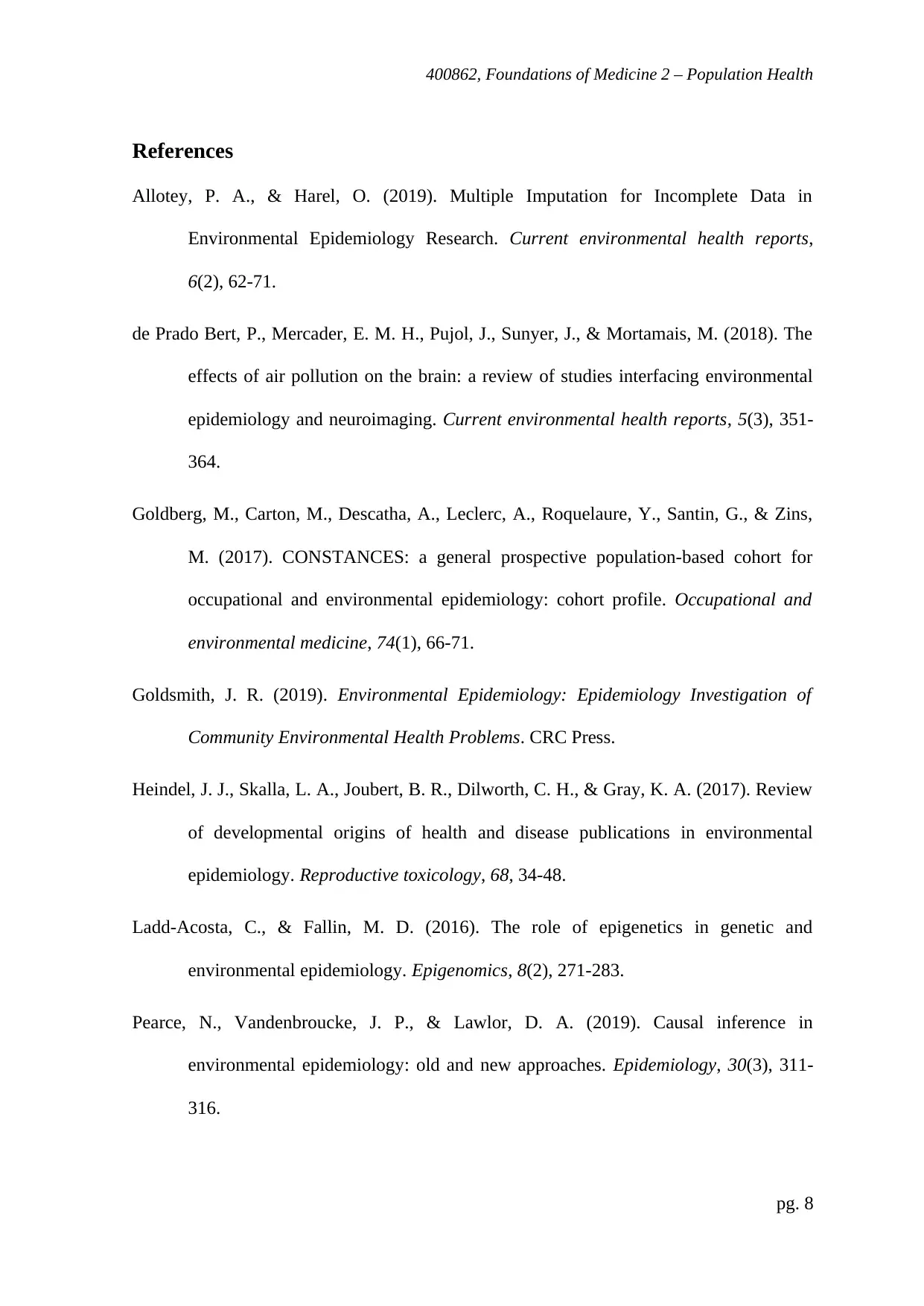
400862, Foundations of Medicine 2 – Population Health
References
Allotey, P. A., & Harel, O. (2019). Multiple Imputation for Incomplete Data in
Environmental Epidemiology Research. Current environmental health reports,
6(2), 62-71.
de Prado Bert, P., Mercader, E. M. H., Pujol, J., Sunyer, J., & Mortamais, M. (2018). The
effects of air pollution on the brain: a review of studies interfacing environmental
epidemiology and neuroimaging. Current environmental health reports, 5(3), 351-
364.
Goldberg, M., Carton, M., Descatha, A., Leclerc, A., Roquelaure, Y., Santin, G., & Zins,
M. (2017). CONSTANCES: a general prospective population-based cohort for
occupational and environmental epidemiology: cohort profile. Occupational and
environmental medicine, 74(1), 66-71.
Goldsmith, J. R. (2019). Environmental Epidemiology: Epidemiology Investigation of
Community Environmental Health Problems. CRC Press.
Heindel, J. J., Skalla, L. A., Joubert, B. R., Dilworth, C. H., & Gray, K. A. (2017). Review
of developmental origins of health and disease publications in environmental
epidemiology. Reproductive toxicology, 68, 34-48.
Ladd-Acosta, C., & Fallin, M. D. (2016). The role of epigenetics in genetic and
environmental epidemiology. Epigenomics, 8(2), 271-283.
Pearce, N., Vandenbroucke, J. P., & Lawlor, D. A. (2019). Causal inference in
environmental epidemiology: old and new approaches. Epidemiology, 30(3), 311-
316.
pg. 8
References
Allotey, P. A., & Harel, O. (2019). Multiple Imputation for Incomplete Data in
Environmental Epidemiology Research. Current environmental health reports,
6(2), 62-71.
de Prado Bert, P., Mercader, E. M. H., Pujol, J., Sunyer, J., & Mortamais, M. (2018). The
effects of air pollution on the brain: a review of studies interfacing environmental
epidemiology and neuroimaging. Current environmental health reports, 5(3), 351-
364.
Goldberg, M., Carton, M., Descatha, A., Leclerc, A., Roquelaure, Y., Santin, G., & Zins,
M. (2017). CONSTANCES: a general prospective population-based cohort for
occupational and environmental epidemiology: cohort profile. Occupational and
environmental medicine, 74(1), 66-71.
Goldsmith, J. R. (2019). Environmental Epidemiology: Epidemiology Investigation of
Community Environmental Health Problems. CRC Press.
Heindel, J. J., Skalla, L. A., Joubert, B. R., Dilworth, C. H., & Gray, K. A. (2017). Review
of developmental origins of health and disease publications in environmental
epidemiology. Reproductive toxicology, 68, 34-48.
Ladd-Acosta, C., & Fallin, M. D. (2016). The role of epigenetics in genetic and
environmental epidemiology. Epigenomics, 8(2), 271-283.
Pearce, N., Vandenbroucke, J. P., & Lawlor, D. A. (2019). Causal inference in
environmental epidemiology: old and new approaches. Epidemiology, 30(3), 311-
316.
pg. 8
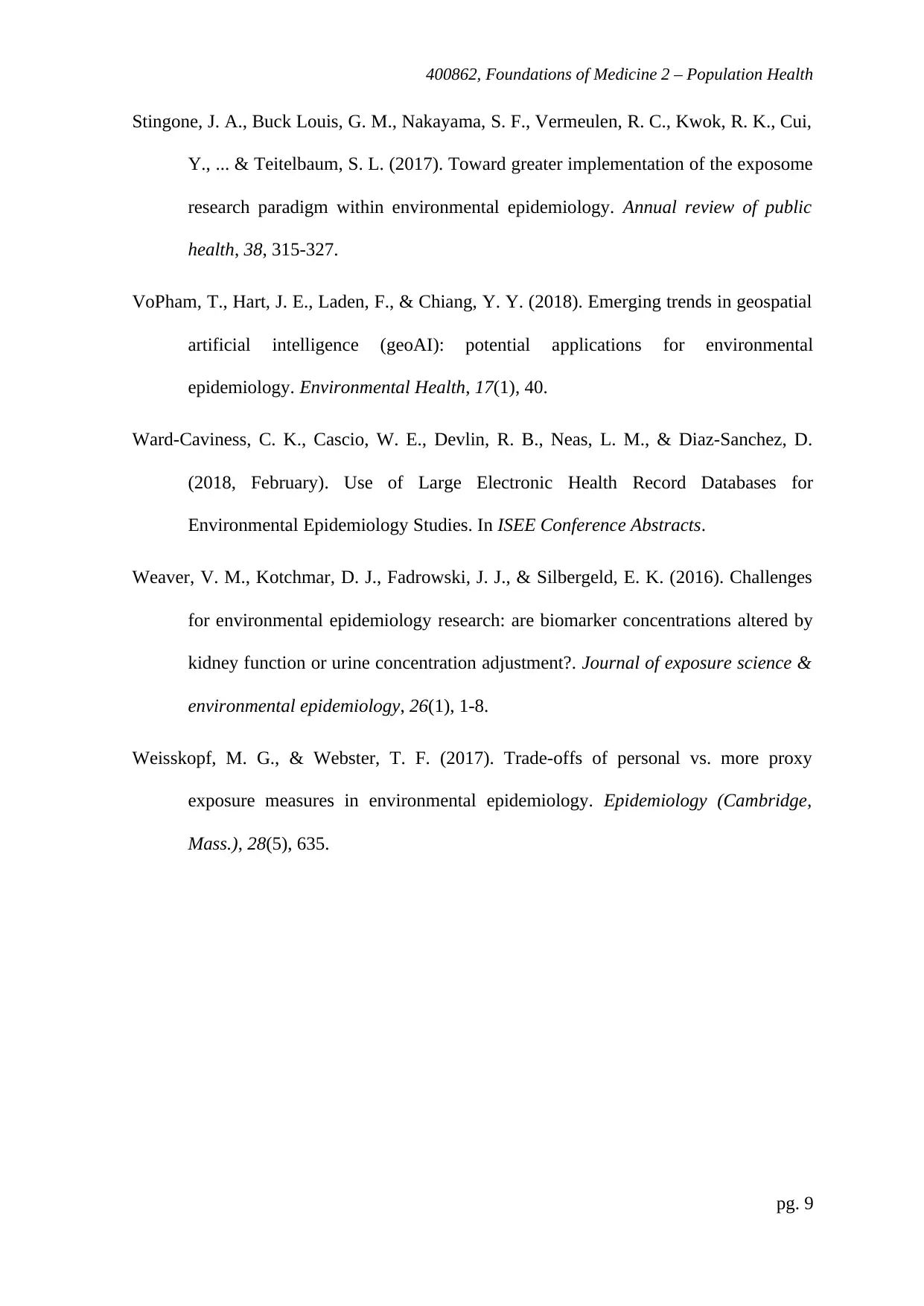
400862, Foundations of Medicine 2 – Population Health
Stingone, J. A., Buck Louis, G. M., Nakayama, S. F., Vermeulen, R. C., Kwok, R. K., Cui,
Y., ... & Teitelbaum, S. L. (2017). Toward greater implementation of the exposome
research paradigm within environmental epidemiology. Annual review of public
health, 38, 315-327.
VoPham, T., Hart, J. E., Laden, F., & Chiang, Y. Y. (2018). Emerging trends in geospatial
artificial intelligence (geoAI): potential applications for environmental
epidemiology. Environmental Health, 17(1), 40.
Ward-Caviness, C. K., Cascio, W. E., Devlin, R. B., Neas, L. M., & Diaz-Sanchez, D.
(2018, February). Use of Large Electronic Health Record Databases for
Environmental Epidemiology Studies. In ISEE Conference Abstracts.
Weaver, V. M., Kotchmar, D. J., Fadrowski, J. J., & Silbergeld, E. K. (2016). Challenges
for environmental epidemiology research: are biomarker concentrations altered by
kidney function or urine concentration adjustment?. Journal of exposure science &
environmental epidemiology, 26(1), 1-8.
Weisskopf, M. G., & Webster, T. F. (2017). Trade-offs of personal vs. more proxy
exposure measures in environmental epidemiology. Epidemiology (Cambridge,
Mass.), 28(5), 635.
pg. 9
Stingone, J. A., Buck Louis, G. M., Nakayama, S. F., Vermeulen, R. C., Kwok, R. K., Cui,
Y., ... & Teitelbaum, S. L. (2017). Toward greater implementation of the exposome
research paradigm within environmental epidemiology. Annual review of public
health, 38, 315-327.
VoPham, T., Hart, J. E., Laden, F., & Chiang, Y. Y. (2018). Emerging trends in geospatial
artificial intelligence (geoAI): potential applications for environmental
epidemiology. Environmental Health, 17(1), 40.
Ward-Caviness, C. K., Cascio, W. E., Devlin, R. B., Neas, L. M., & Diaz-Sanchez, D.
(2018, February). Use of Large Electronic Health Record Databases for
Environmental Epidemiology Studies. In ISEE Conference Abstracts.
Weaver, V. M., Kotchmar, D. J., Fadrowski, J. J., & Silbergeld, E. K. (2016). Challenges
for environmental epidemiology research: are biomarker concentrations altered by
kidney function or urine concentration adjustment?. Journal of exposure science &
environmental epidemiology, 26(1), 1-8.
Weisskopf, M. G., & Webster, T. F. (2017). Trade-offs of personal vs. more proxy
exposure measures in environmental epidemiology. Epidemiology (Cambridge,
Mass.), 28(5), 635.
pg. 9
⊘ This is a preview!⊘
Do you want full access?
Subscribe today to unlock all pages.

Trusted by 1+ million students worldwide
1 out of 9
Related Documents
Your All-in-One AI-Powered Toolkit for Academic Success.
+13062052269
info@desklib.com
Available 24*7 on WhatsApp / Email
![[object Object]](/_next/static/media/star-bottom.7253800d.svg)
Unlock your academic potential
Copyright © 2020–2025 A2Z Services. All Rights Reserved. Developed and managed by ZUCOL.





